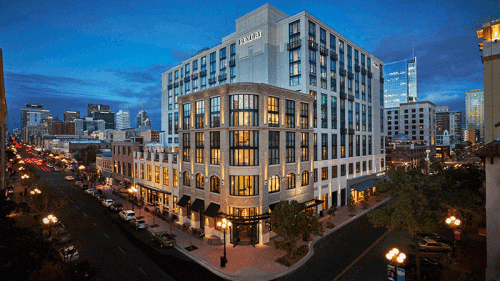Hotels and Resorts
Florida remains one of the healthiest worldwide hospitality centers. Hotel occupancy in Miami-Dade rose to 87.9 percent in March from 85.7 percent in the same month last year, and the average daily room rate in was also up. At a panel discussion during ULI’s 2018 Florida Summit, two hotel developers shared how their decision to lean into the evolving trends within hospitality and tourism have bred overwhelming success.
To meet the evolving expectations of today’s travelers, new hotels are being infused with active, social spaces that encourage interaction between guests, offer unique experiences with local flavor, and provide healthy lifestyle amenities, said experts speaking at a ULI San Diego/Tijuana event.
Imagine arriving home after a long day at the office and calling room service to have a chef-prepared meal delivered to your door. For residents of Nashville’s new, innovatively designed Aertson Midtown building, that is not wishful thinking. They simply place an order with the signature restaurant of the Kimpton hotel that shares their apartment building.
Set against an urban landscape of concrete, steel, and glass in Tanjong Pagar, Singapore’s central business district, Oasia Hotel Downtown (OHD) stands out with its red silhouette clad in lush greenery. An integrated hotel/office development comprising a 27-story, 314-room business hotel and 100 new-age offices, OHD responds to the government’s vision for the precinct earmarked as the island’s next waterfront city with a mix of business, commercial, and residential activities.
Since Airbnb began to disrupt the U.S. hospitality sector, industry leaders have been thinking about ways to attract previously underserved customers. A number of recently built hotels and resorts combine the space and amenities of a private home with high-end amenities, concierge service, and curated experiences. A 2017 ULI Fall Meeting session presented two recently introduced concepts with distinctly different target markets and price points.
After years of steady growth, the hotel industry is bracing for a tough year. “Growth and revenue are slowing down,” Bruce Baltin, managing director of CBRE Hotels, told executives and experts gathered for ULI’s “Hotel and Resort Development: Next Wave of Innovation” conference in La Costa, California, held in June. “It’s hit a peak. We think we’re at a plateau.”
As competition for the dollars of vacationers and business travelers ratchets up, hotel companies are on a never-ending search for ways to differentiate themselves. Guests are looking for uniqueness, local flavor and history, and bespoke experiences that they can capture and share instantly through social media networks, according to a panel of hotel industry experts at the recent ULI Florida Summit in Miami.
The focus of most panelists at ULI’s Latin America Conference, held in late October, was on the stronger markets, including Mexico, Colombia, Peru, and Chile. There also was optimism about a turnaround in Brazil and Argentina’s most recent election.
Newly confident and deep-pocketed consumers are driving vacation-home sales to levels that have not been seen in a decade, said panelists at the ULI Fall Meeting. But prices have not yet reached previous peaks, and buyers are increasingly cautious and cost-conscious.
In a competitive global market, resort designers are racing to define the “new luxury.” The modern concept of luxury is “really about elegance and simplicity,” said Richard Centolella, a principal in design firm EDSA, during a panel discussion at the ULI Fall Meeting.





